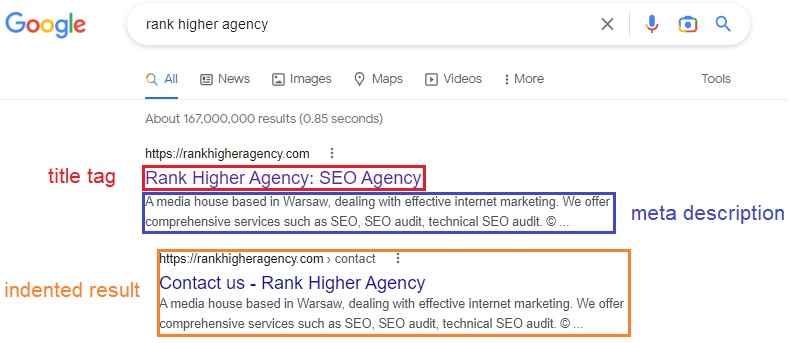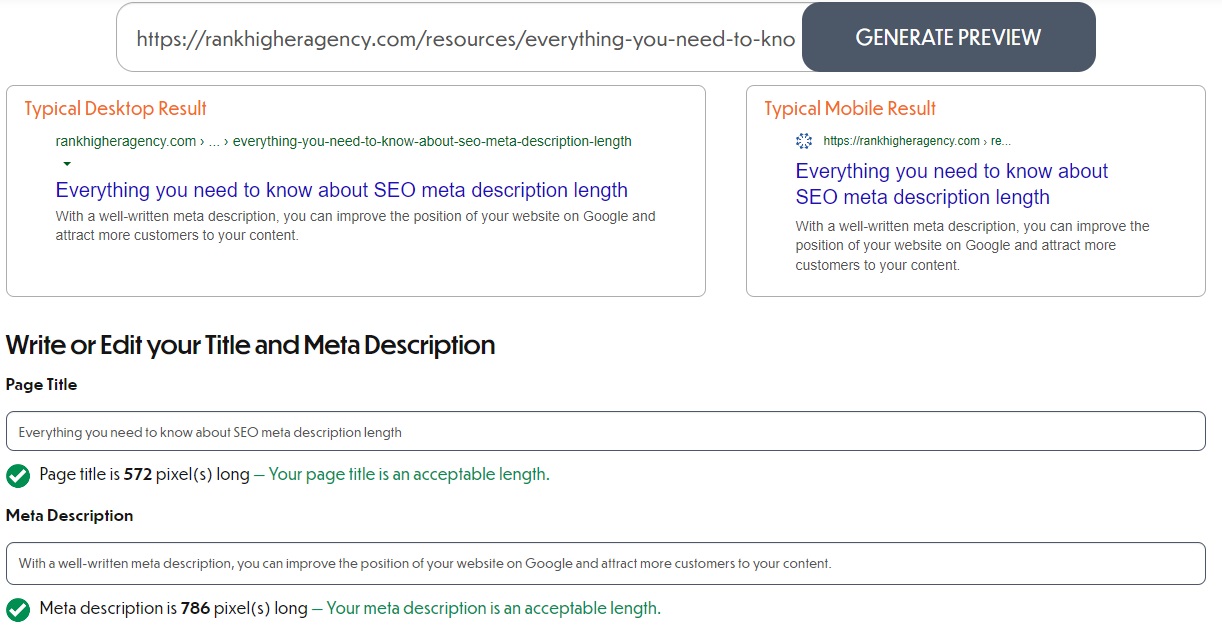Everything you need to know about SEO meta description length
If you take care of the positioning of your web page, you surely know there are many elements influencing your page’s visibility in Google search results. The on-page SEO elements comprise things like code optimization, title tags, meta description tags, and a whole list of additional HTML and content-related elements. In this article, however, we are going to talk strictly about meta descriptions and their role in search results. The truth is, with a well-written meta description, you can improve the position of your website on Google and communicate your content in a clear way so that it can attract more customers. What do you need to know about title and meta descriptions, and how can you craft them for the purpose of improving your website’s position on the search engine results page? Let’s find out!
What is a meta description?
A meta description is a small piece of information about your website that’s presented on the search engine results page (SERP). All major search engines, including Google and Bing, use them to show users what they can find under a given link. However, f
Every web page, in order to display in Google correctly, needs so-called metadata. These are small pieces of information about your website’s content and structure. Google considers two types of metadata especially important:
- Title tag: It’s a small HTML element that specifies the title of a given web page.
- Meta description tag: It’s a short text describing what a given website is all about.
Both these tags are verified by Google bots, but they come in handy also concerning your current and potential customers. That’s because these tags are displayed on the SERP page. Here’s how it looks like in Google search results:

Title tag, meta desctiption and indented result on Google’s Search Engine Result Page.
In the picture above, you can see these two elements, plus an additional one. You can see that Google chose the same meta description for both home and contact page, even though we filled the meta tags with unique content. Maybe Google is telling us it’s time to optimize 🙂
Google started showing indented results (meaning, more than one result per domain, stacked one under another) as early as 2007, but it became common in 2021. Indented results use title tag and meta description in the same way as normal result.
There are also links that are clustered together in rows and columns under a web result (usually, the home page) that are called sitelinks. For the sitelinks, Google usually takes the anchor of the link that can be found in fixed elements of the page (top/side menu, footer). They are used to guide Google users more effectively by showing them basic navigation to the site:

You can see that Apple currently has four sitelinks, grouped in one column and a search bar. It can change based on what keyword phrase we feed into the Google prompt line.
You can affect how sitelinks are being displayed in Google by changing the navigation on the page. However, that’s a story for a different article. Today, we are interested in meta descriptions and how to optimize them so Google shows not what Google wants, but what you (or your potential customers) want.
The first thing you have to think about meta description length.
What is the perfect meta description length for Google?
You have to be aware that there is a limited amount of space. Google displays descriptions having a length of a maximum of 160 characters (desktop results) or 120 characters (mobile search results). Of course, your description can be longer, but in such a situation, users will see just the first part of it. Obviously, that defeats the purpose of this piece of data. Therefore, you need to be concise and get straight to the point. We will talk about how to create a perfect meta description tag in a few moments.

There are many free meta description tag length checking tools on the Web. Here’s length in pixels for both metatags.
Meta description lengths for other search engines
What about other search engines? We could generally say that Google standards apply to other search engines as well. Both Yahoo! and Bing have a rough character limit of about 170 characters. When it comes to mobile search results, the standard of 120 characters is applicable, too.
Now, you have to remember that in 2022, over 50% of search queries come from mobile devices. Therefore, a good meta description should contain all the most important elements in the first 120 characters so that mobile users can make the most of them. Mobile-friendliness is a requirement that applies to everything you do online, including your website, social media activity, and metadata.
Quick side note: There is a second way to calculate the length of your meta descriptions – with pixels. Here, we talk about 920 pixels in desktop search and about 680 pixels in mobile search. However, we realize that it’s much easier to operate on lengths provided in a number of characters in everyday use, so you can just stick to that.
Does a meta description have an influence on your website’s SEO?
The answer to that question is not that obvious. Perhaps you’ve heard that meta descriptions don’t have a direct influence on the position of your page in Google. And yes, to some extent, that’s true. And there is a very rational argument for that – if meta descriptions affected SEO directly, all you would have to do to reach the first page in Google was fill them with keywords and key phrases. Of course, people working in Mountain View (Google headquarters) knew that as well, so it’s not that simple. However, this doesn’t mean that meta descriptions do not influence SEO at all.
You need to remember that meta description appears directly under the link to your website. This means that, when properly written, it can encourage users to go to your webpage. And the more clickable (that’s measured with the so-called click-through rate) your site is, the better position it gets in Google. So does a meta description impact your position in search engines? Yes, without a doubt!

Knowing how to approach these pieces of metadata, you will be able to avoid duplicate meta descriptions and focus on the searcher’s query. A great meta description shows the page’s content. It doesn’t need to be filled with the results of your keyword research. On the contrary, it should just accurately describe what users can find after they click your link. It’s really that simple!
And you have to know that Google carefully analyzes your click-through rates. If users looking for a specific product or asking a specific question frequently click your link, Google will assume you are a good go-to place and will put your website higher on the SERP page for similar queries.
Therefore, you have but one goal here: to write meta descriptions so that they can encourage potential customers to visit your webpage. To help you with this assignment, we’ve made a short guide on how to write them.
How to write a perfect meta description
If your existing meta description is filled with keywords, most likely you need to implement some changes and adjust your way of thinking about it. Here, you target customers, not Google bots. So what should you do?
Write descriptions that accurately describe your subpage, not keywords that you want to promote. Secondly, stick to optimal lengths both for desktop and mobile devices. And thirdly, use SEO tools to craft your meta descriptions. A perfect example of such a free SEO tool is the Yoast plugin that you can use for websites built with WordPress. YoastSEO, even in its free plan, is sufficient for the vast majority of SEO-related activities. Among other applications, you can use it to set the best SEO titles and meta descriptions. This plugin will also inform you whether your metadata has an optimal length. Of course, you can also use Word to calculate the length of your meta description, but if you use YoastSEO either way, that’s just a more convenient option.
Always remember to think about your metadata as an opportunity to display a free advertisement to your potential customers. To show you what we have in mind, let’s use a quick example. Suppose you run an SEO agency. Which description of your business is more encouraging? This one?
SEO agency London, search engine optimization services, Google results, website optimization
Or this one?
See why we are the best SEO agency for your business. Check our experience and the results in Google we deliver.
The answer is obvious, isn’t it? That’s why you ought to write for your audience, not just Google bots. Even though there are fewer keywords in the second version, it’s more attractive and engaging from the reader’s perspective. And that’s exactly what you need.
Master meta descriptions and thrive in Google
To sum up, if you want to optimize meta descriptions in your online business, remember these three simple rules:
- Stick to a recommended length. In our opinion, it’s best to limit yourself to just 120 characters, no matter which search engine you are interested in. This way, you can reach all users (both desktop and mobile) effectively. If you want to focus just on desktop users, the optimal limit is 150-160 characters.
- Write meta descriptions with customers in mind. When it comes to metadata, keyword stuffing doesn’t work. It won’t get you any further and can even discourage potential users. Write descriptions that are engaging and attractive from a reader’s perspective. Think of them as free ads for your company.
- Use SEO tools and make sure each subpage and each blog post has a meta description. If you leave a given subpage without a description, Google bots will automatically assign one. In general, you don’t want that. That’s why we encourage you to verify if all of your subpages (including product tabs and blog posts) have metadata assigned to them.
Now you know how to write a perfect meta description. We hope you found the knowledge in this article useful! If you want to know more about positioning your website in Google – drop us a line! Our SEO experts will happily take care of your website. We’re waiting for your message!
